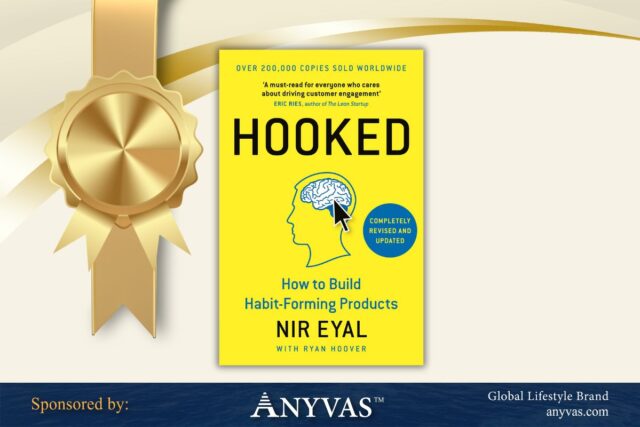
Nir Eyal’s Hooked: How to Build Habit-Forming Products delivers a blueprint for creating products that seamlessly integrate into consumers’ daily lives, making them indispensable. This insightful guide provides readers—particularly marketers, product designers, and business leaders—with actionable steps to build products that don’t just attract users but engage them long-term through powerful behavioral techniques. Having read this book thoroughly, I am confident that its value lies in the practical, ethical, and impactful insights it provides, especially relevant to those in business who aim to foster strong customer relationships and loyalty.
Understanding the Hook Model: The Core of Habit Formation
The core of Hooked is Eyal’s Hook Model, a four-step framework designed to help creators build habit-forming products. Eyal’s model explains how products can tap into the psychology of habit formation, essentially creating loops that keep users returning, sometimes instinctively. The Hook Model’s four stages—Trigger, Action, Variable Reward, and Investment—reveal the psychological mechanisms that turn one-time users into habitual customers.
1. Trigger: The Hook Model begins with a trigger—an external prompt like an email, notification, or message that nudges the user into action. However, the ultimate goal is to create internal triggers, so the product becomes associated with emotions like boredom, loneliness, or stress. Through repetition, users eventually reach for the product automatically, driven by these internal cues.
2. Action: Action follows the trigger, and Eyal emphasizes the need for ease and simplicity here. Drawing from behavioral psychology, he explains that motivation, ability, and a well-placed trigger combine to encourage the user to perform a desired behavior. Eyal demonstrates how simplifying actions—such as making a purchase or browsing content—can increase engagement by removing friction.
3. Variable Reward: This stage taps into the psychological principle of uncertainty to keep users coming back. By adding a degree of unpredictability to the reward, the product creates an experience that feels fresh and rewarding every time, much like the experience of scrolling through a social media feed. Eyal’s insights into this stage show how variation in rewards can foster deeper engagement and emotional connections.
4. Investment: The final step involves user investment, where users put in effort, time, or data that enhances the product’s value for them. Eyal argues that this phase cements commitment, as users become more invested in products they’ve contributed to. This phase is particularly powerful because it transforms passive users into active participants, increasing their likelihood of returning.
Practical Takeaways for Marketers and Product Designers
Eyal’s model is a treasure trove of actionable advice for those in marketing and product design, offering specific strategies for creating compelling user experiences. By using internal and external triggers, making actions intuitive, and incorporating variable rewards, business leaders can design products that engage users beyond initial interactions. Marketers, in particular, can draw from Eyal’s insights on triggers and rewards to craft campaigns that naturally encourage repeat engagement.
The book also underscores the importance of ethical considerations in building habit-forming products, advising designers to focus on products that enhance users’ lives rather than exploiting addictive tendencies. Eyal provides a balanced approach, stressing the need for what he calls “behavioral design ethics” to avoid manipulative practices. This focus on responsibility is refreshing and essential, especially in an era where digital products are central to daily life.
Strengths of Hooked: An Accessible Guide with Real-World Applications
One of the strengths of Hooked is its accessibility. Eyal’s writing is clear, concise, and well-structured, making complex psychological concepts easy to grasp. Through a blend of psychology, case studies, and practical advice, Eyal explains how widely used products—from Instagram to the iPhone—leverage the Hook Model, grounding his ideas in familiar, real-world examples. This approach makes the book suitable not only for experts in behavioral psychology but also for business leaders, marketers, and designers seeking an introduction to habit formation.
Moreover, Eyal’s insights are not confined to digital products. The principles he shares can apply to any business model that requires consistent customer engagement, making the book widely applicable. His emphasis on actionable strategies—like reducing friction in the user experience or using small investments (like user-generated content) to increase commitment—makes this book an essential guide for those looking to create or refine products.
Limitations: A Narrow Focus on Engagement with Less Emphasis on Broader Impact
Despite its strengths, Hooked has a few limitations. One notable drawback is its primary focus on maximizing engagement, sometimes at the expense of broader discussions on product sustainability or user well-being. Although Eyal does address ethical concerns, these discussions are often brief, leaving some readers wanting more on how to balance engagement with long-term user benefits. Business leaders may find themselves questioning how to implement these techniques while maintaining a healthy balance between user retention and ethical responsibility.
Additionally, Hooked is most valuable to those already involved in product design or marketing. Readers who are new to these fields may find the discussions on behavioral triggers and rewards slightly abstract if they lack a foundational understanding of psychology. The book’s case studies could also be expanded, as some readers might benefit from examples outside the technology and social media sectors.
Why Hooked is Essential Reading for Business Leaders
Overall, Hooked by Nir Eyal is a compelling and informative guide for anyone interested in creating products that users love and consistently engage with. Eyal’s Hook Model is an invaluable tool for marketers and product designers, providing a structured approach to building habit-forming products that benefit both businesses and their users. From actionable insights into the psychology of engagement to ethical considerations in design, Eyal’s work resonates with today’s need for products that fit seamlessly into users’ lives.
Having read this book, I strongly recommend it to business leaders, especially those focused on digital marketing and product development. Eyal’s methods, while geared toward engagement, ultimately challenge us to think about the long-term value we create for users. Hooked offers not just techniques for capturing attention but a framework for building products that sustain loyalty in a competitive marketplace. With this book, readers can gain a deeper understanding of how psychology drives consumer behavior and, ultimately, how to harness these insights to build lasting connections.
To get more insights from our Book Recommendation section, please click here.
Read more write-ups of this author: Click Here

About The Author:
Mirza Rakib Shovon
President
MRS Group of Companies




















